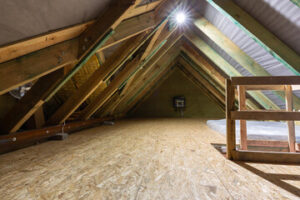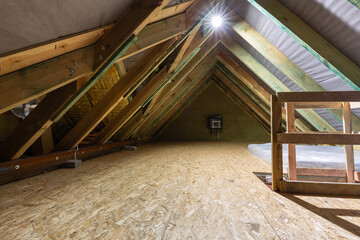Fiberglass is the most common type of attic insulation. It is a very effective material that saves you money over time by preventing airflow. It is also environmentally friendly.
Fiberglass is a plastic reinforced with tiny glass particles. It is available in blanket form, or in a rolled version that can be cut to fit around pipes and other obstructions. You can ask Ultimate Radiant Barrier experts if you want to learn more.
 Easy To Install
Easy To Install
When compared to other insulation materials, fiberglass attic insulation is one of the easiest to install. It is available in rolled sheets (batts) that are pre-cut to fit between wall studs and ceiling joists, which makes it a popular DIY option for homeowners looking to save on installation costs. Unlike other types of insulation, fiberglass doesn’t retain moisture or support the growth of mold or mildew, making it ideal for attics in humid climates. However, the airborne fibers that comprise fiberglass aren’t healthy to inhale, so it’s important to wear a face mask during installation and to avoid touching or breathing the material.
Another advantage of fiberglass is its fire resistance. It is non-flammable and will not burn or cause wood framing to catch fire, which can be a huge benefit in case of an attic fire. Additionally, it is a great choice for those living in colder climates, as it is highly effective at keeping heat from radiating up through the attic space and into the home.
Fiberglass insulation is available in a wide variety of R-values to suit any needs. The higher the R-value, the better it will insulate. However, it’s important to remember that higher R-value insulation tends to be more expensive, so be sure to weigh your options carefully before choosing the type of attic insulation you want to purchase.
Whether you’re installing fiberglass batts or blown-in loose fill, both are easy to install in your attic. However, if you’re working with spray foam or cellulose, it’s best to hire a professional installer to ensure that your installation is done correctly. This will minimize the risk of disrupting existing wiring and putting too much strain on your attic’s ceiling joists, which could potentially lead to structural damage over time.
Before installing attic insulation, be sure to take a flashlight and place two sheets of plywood on the attic floor. This will protect the integrity of your attic and help you avoid the risk of injury if you fall during the installation process. It’s also a good idea to identify any uncovered electrical boxes and exposed ducts before insulating.
Cheap
Fiberglass insulation is a cost-effective option for homeowners who want to add or upgrade their attic’s existing insulation. It’s also relatively easy for a homeowner to install on their own. It can be purchased in bags at most home improvement stores, and some manufacturers also offer it in a rolled form called fiberglass batts that fit between standard joists to reduce installation time and effort.
The main ingredient in this type of insulation is recycled glass, which is bound together using a chemical binder. This makes it more durable and gives the material its insulating properties. The use of recycled materials is a benefit for the environment as it conserves non-renewable resources. This makes fiberglass insulation a green choice, especially when compared to other products that use antiquated materials or contain chemicals such as formaldehyde and asbestos.
It also has good acoustical properties, which helps to reduce noise from the attic floor or walls. This is important in homes with loud neighbors or a heating and cooling unit that isn’t quite enough. It is available in a variety of thicknesses, which determine the amount of heat it can resist or the “R-value” it offers.
Unlike cellulose, fiberglass can withstand moisture without losing its insulating properties. However, it can be subject to mildew and mold growth if exposed to dampness or standing water over a prolonged period. Therefore, it’s best used in homes with proper attic ventilation to avoid these issues.
When properly installed, this insulation can help save energy costs by reducing the amount of heat that escapes through the ceiling and into the living space below. It is especially effective in older homes with outdated insulation that needs to be replaced.
However, if you live in a humid climate and have existing cellulose insulation, it may be worth upgrading to blown fiberglass to prevent moisture problems in the attic. Both insulation types require proper attic ventilation to prevent moisture buildup, but fiberglass is more resilient than cellulose, which requires frequent maintenance in areas that are subject to high humidity.
Environmentally Friendly
The common fiberglass insulation found in attics is often considered “green.” Its production requires fewer resources than its more environmentally harmful counterparts, and it’s also made from recycled materials. It is also very lightweight, which cuts down on heating and cooling costs. It also reduces greenhouse gas emissions and other air pollutants. However, it’s important to note that this type of insulation is not considered green if it contains irritants that can cause rashes on your skin or respiratory problems. It’s also not a good idea to handle it with bare hands, as it can release tiny glass particles that can irritate the skin and cause respiratory problems. If you must use it, be sure to wear long sleeves and pants, eye protection, a face mask, and gloves.
Another environmentally friendly option for attic insulation is cellulose. This is usually blown into the attic by an experienced professional. It’s usually made from recycled paper and treated with borate or ammonium sulfate to make it flame-resistant. It’s denser than fiberglass and has an R-value of about 3.5 per inch. This helps to prevent the spread of fires in the attic.
However, it’s important to remember that cellulose insulation does not eliminate air movement in the attic and can leave gaps. It also has a lower R-value per inch than fiberglass and does not completely stop convective heat movement. This type of insulation can be less expensive than fiberglass, but it may not be ideal for homes that have ducts in the attic.
Regardless of the type of attic insulation you choose, it’s important to have it installed properly. Using the correct R-value for your climate zone will help reduce your energy consumption and lower your energy bills. Contact a pro to find out the correct R-value for your home and how much insulation you will need. Getting the right amount of insulation can reduce your utility bills by up to 15%. It will also save you money in the long run.
Longevity
There are many different types of insulation available, and they all have their lifespans. Fiberglass is one of the more durable options, and it can last anywhere between 80 and 100 years. However, this longevity is only possible if it is maintained properly and does not experience any major disruptions or damage. This type of insulation is not immune to moisture or other environmental factors, so it is important to keep an eye on your home and inspect it regularly for any signs of damage.
In addition to its longevity, fiberglass is also a highly effective choice for insulating your home. It is naturally adept at trapping pockets of air, which helps to keep your house warm in the winter and cool in the summer. This type of insulation can also significantly decrease external noise and provide soundproofing benefits.
Compared to other types of insulation, such as cellulose and spray foam, fiberglass is more environmentally friendly. This is because it is made from recycled materials, and it has a higher post-consumer recycling content. It is also resistant to mold and fungus, which can cause significant health issues for residents. It can be installed either loose-fill or blown in, which allows it to reach hard-to-reach areas.
The biggest issue with fiberglass insulation is its susceptibility to settling and compaction. This can occur if it is subjected to excess moisture or heavy objects are stored on top of it. However, the good news is that if this happens, it can be easily remedied by installing new insulation.
When comparing fiberglass to other types of insulation, such as mineral wool and cellulose, it is important to consider the overall cost and environmental impact of each option. Mineral wool is expensive and has a shorter lifespan than fiberglass, but it is fire-resistant and provides a high level of air protection. Cellulose is also eco-friendly and offers a similar level of protection to fiberglass, but it can be susceptible to moisture and mold growth. This is why it is best to use a professional insulation crew when installing this type of product.

